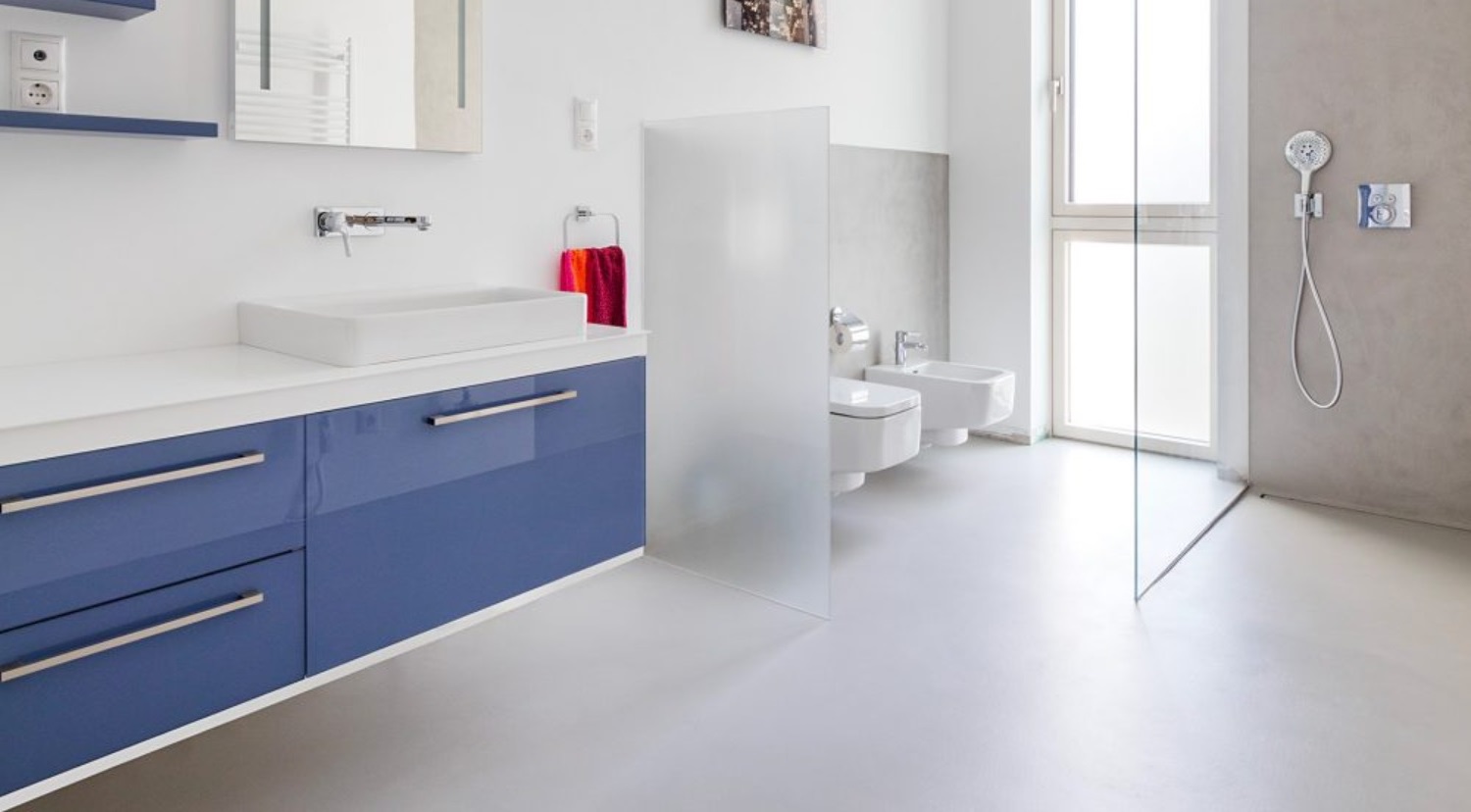Tiled bathrooms are becoming increasingly popular in modern interior design. This trend reflects the desire for minimalist but still warm and inviting spaces. Traditional tiles, while versatile and practical, often limit design options and can make the bathroom look monotonous after a while. On the other hand, alternative materials such as plaster, micro cement, natural stone, wood and Glass offer various textures and colours and open up new horizons for creative and individual interior design.
These alternatives promise visual improvements and practical durability that meets the specific requirements of the bathroom. The following article highlights four creative approaches to tileless bathrooms that harmoniously blend aesthetics and functionality, paving the way for innovative design concepts.
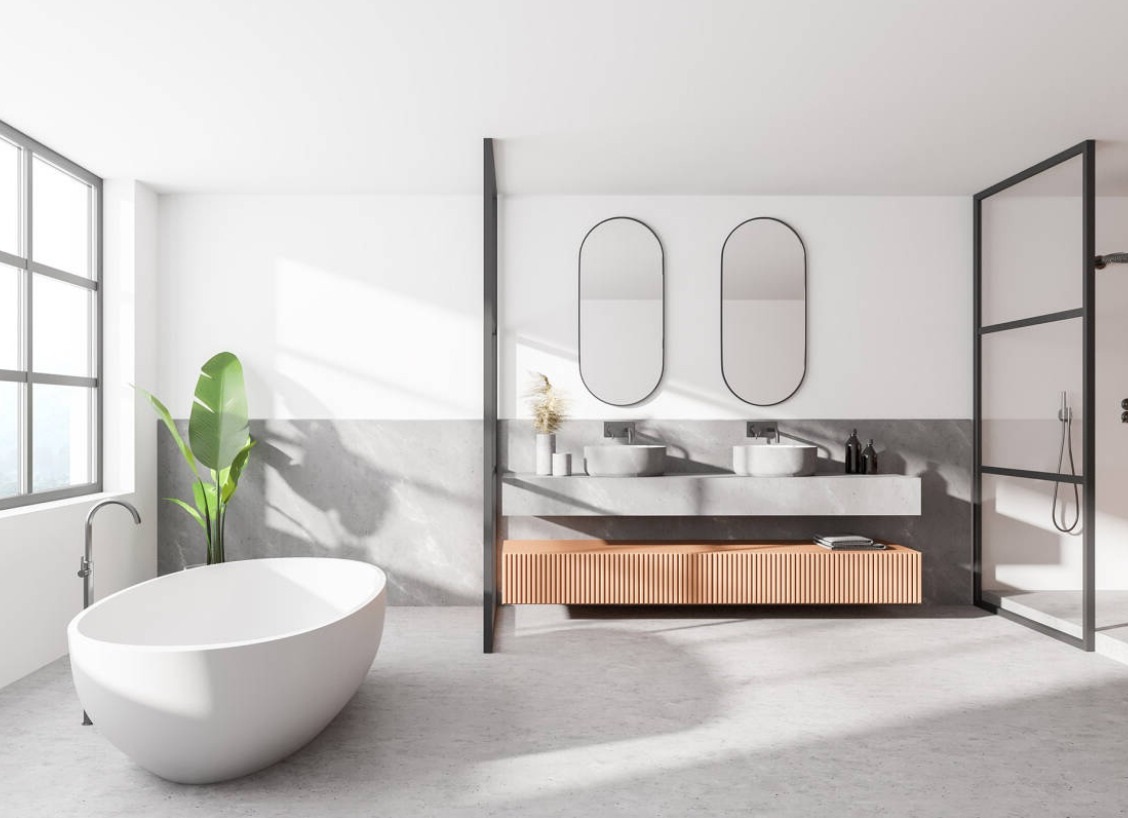
Summary: 10 facts about tileless bathroom designs
- Tiled bathrooms use plaster, micro cement, natural stone, wood and Glass for a unique design.
- Selected wood types and unique treatments make the wood suitable for humid bathroom environments.
- Natural stone and other materials are easy to clean with pH-neutral cleaners and require regular sealing.
- The use of Glass in shower cubicles and as room dividers maximizes light distribution and creates the impression of an open space.
- Various textures, colours and finishes allow for individual interior designs that reflect personal style.
- Proper selection and care of the materials used maintain their beauty and function for many years.
- Bamboo and certain resins offer an environmentally friendly alternative to traditional bathroom materials.
- The combination of different materials opens up new design possibilities for the bathroom.
- Innovative materials and design concepts modernize the bathroom into a comfortable space.
- Careful selection of materials and design elements allows for creating a private retreat that promotes relaxation and well-being.
The Importance of Tile-Free Bathroom Design
Tiled-free bathroom designs represent a departure from traditional design concepts. They symbolize the minimalist style trend that emphasizes purity and tranquillity. By avoiding bathroom tiles, a space is created that is aesthetic and functional. Materials such as micro-cement or natural stone offer innovative solutions that guarantee long life and low maintenance.
Particular emphasis is placed on a harmonious combination of design and practicality in such bathrooms. The selection of alternative materials allows for interior designs that meet personal preferences and lifestyles. These materials contribute to a unique spatial experience often unattainable with traditional tiles.
Sustainability is also playing an increasingly important role in modern bathroom design. Tileless designs are often associated with environmentally friendly materials that benefit people and the planet. Reducing joints and using natural materials also improve hygiene and make cleaning easier.
In conclusion, tile-free bathroom designs answer the increasing need for individuality, sustainability and well-being in our living spaces. They offer various options through which each person can create a refuge of relaxation and peace.
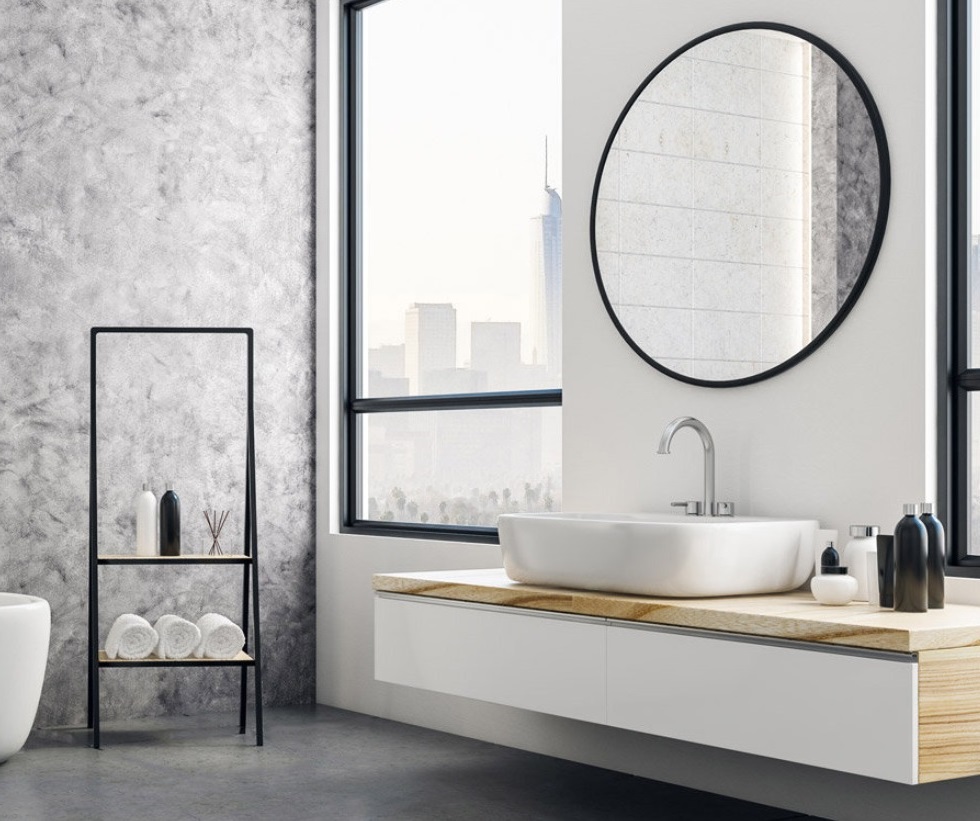
Advantages over traditional tiles
Tiled bathrooms provide visual continuity that creates a feeling of space and openness. Eliminating interference at the joints makes the room appear more oversized and uniform. This approach supports minimalist and modern design by creating clean lines and a calm atmosphere.
Using alternative materials such as micro cement or resin allows customization of colour and texture. Such a finish can be specifically adapted to the bathroom’s overall design, giving it a personal touch and uniqueness. This flexibility allows for creative and innovative room concepts that are difficult to achieve with traditional tiles.
When it comes to maintenance and cleaning, tile-free surfaces offer clear advantages. Cleaning is easier and more effective with no seams to catch dirt and mould. This contributes to a more hygienic environment and reduces the need for harsh cleaning products, benefiting the health of occupants and the environment.
Finally, the advanced properties of alternative materials, such as water resistance and durability, allow them to be used in various bathroom areas. They offer aesthetic and functional solutions for floors, walls, sinks, and shower areas, opening up new possibilities for consistent designs that are impossible with traditional tiles.
Plaster and micro-cement: A subtle solution
Plaster and micro-cement are becoming increasingly popular in modern bathroom design. These materials provide an elegant, seamless appearance and offer an attractive alternative to conventional tiles. Their use transforms the bathroom into a space with flowing transitions and pure aesthetics.
Definition and properties
Plasters and micro-cements are known for their versatility and aesthetic adaptability. Plaster offers a traditional coating method that covers walls with a breathable layer, while micro cement creates a sturdy, water-resistant surface with a smooth texture. Both materials allow for various colours and finishes, from matte to glossy.
These materials are highly valued for their durability and ease of maintenance. Its smooth surface prevents dirt and mould buildup, making it ideal for damp spaces such as bathrooms. They are also resistant to abrasion and easy to repair if necessary.
Possible application in the bathroom
Plaster and micro-cement offer a variety of design options in the bathroom. They can be used not only for walls and floors but also for sinks, countertops and even shower stalls. This flexibility allows for creating uniform or contrasting designs that unify the entire room.
The use of these materials helps create a minimalist but still warm atmosphere. Combining different textures and shades allows you to create an individual look that reflects the owner’s personal touch.
Advantages and disadvantages
The main advantages of plaster and micro cement are their aesthetic flexibility and durability. They offer modern, easy-to-maintain surfaces that give a bathroom a contemporary feel. They are also an excellent choice for allergy-friendly rooms because they do not emit harmful substances.
The initial cost intensity is a possible disadvantage, especially when considering high-quality micro-cements or special plasters. Additionally, its application requires a certain skill level to ensure an even, long-lasting surface. Despite these challenges, the benefits provide a compelling reason to choose a modern bathroom design.
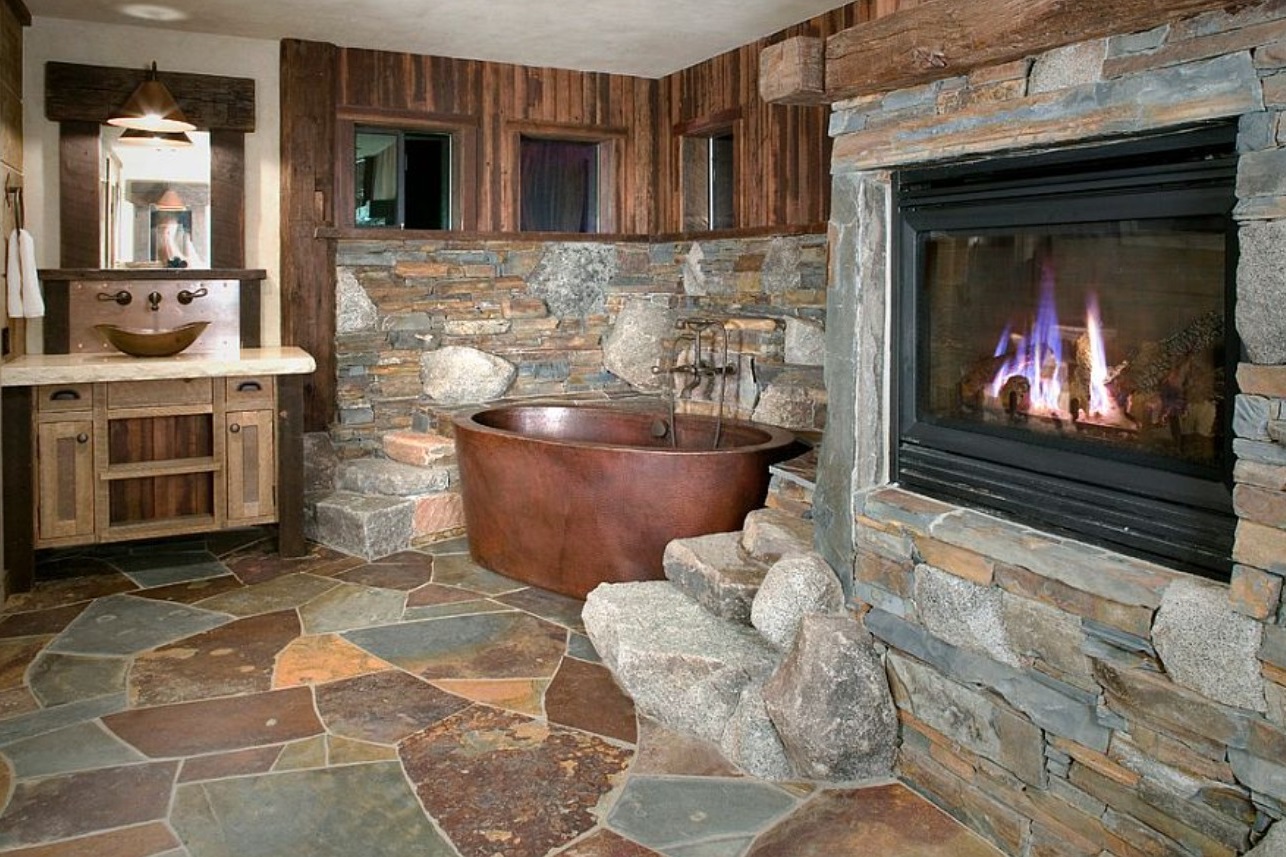
Natural stone: elegance and durability
The natural stone in the bathroom is a symbol of elegance and longevity. This material brings natural beauty directly into the home and creates a calm and luxurious atmosphere. With its natural resistance to moisture and wear, natural stone is an ideal choice for those who prioritize quality and aesthetics.
Types of natural stone for bathrooms
Different types of natural stones offer different looks and properties that make them suitable for bathrooms. With its unique veining and colour patterns, Marble lends a luxurious feel to any room. Known for its hardness and durability, granite is a practical choice for high-traffic areas. Slate provides a non-slip surface in various colours, from black to green.

Natural stone in the bathroom
Travertine is another popular choice that exudes warmth and a touch of sophistication. Its porous structure can be treated with a special sealant to increase longevity. Limestone, with its smooth texture and natural, earthy colour palette, promotes feelings of relaxation and connection with nature.
Care and maintenance
Caring for natural stone in the bathroom requires attention to maintain its beauty and function. To avoid damage from harsh chemicals, it is essential to use cleaning products designed specifically for natural stone. Regular sealing is recommended to protect the stone from water and stains.
Stains should be removed as quickly as possible to prevent penetration into the stone. A soft cloth and mild cleaning agent are sufficient for daily care. When installing, use appropriate joint widths to accommodate the natural movement of the stone and avoid cracking.
Design ideas with natural stone
Natural stone offers a wide variety of design options in bathrooms. Solid stone floors can create a sense of space and unity, while natural stone accent walls provide an impressive focal point. Combining different types and colours of stone can create interesting visual contrasts and highlights.
For a modern interpretation, natural stone can be combined with materials such as Glass or metal to balance naturalness and contemporary elegance. Indirect lighting accentuates the natural beauty of the stone and creates a warm, inviting atmosphere. Every piece of natural stone is unique, meaning every bathroom design is unique.
Wood: warmth and naturalness
Wood in the bathroom combines warmth and naturalness and creates an inviting atmosphere. Despite the humidity challenges in the bathroom, certain types of wood and maintenance methods can make wood a durable and beautiful material for this space.
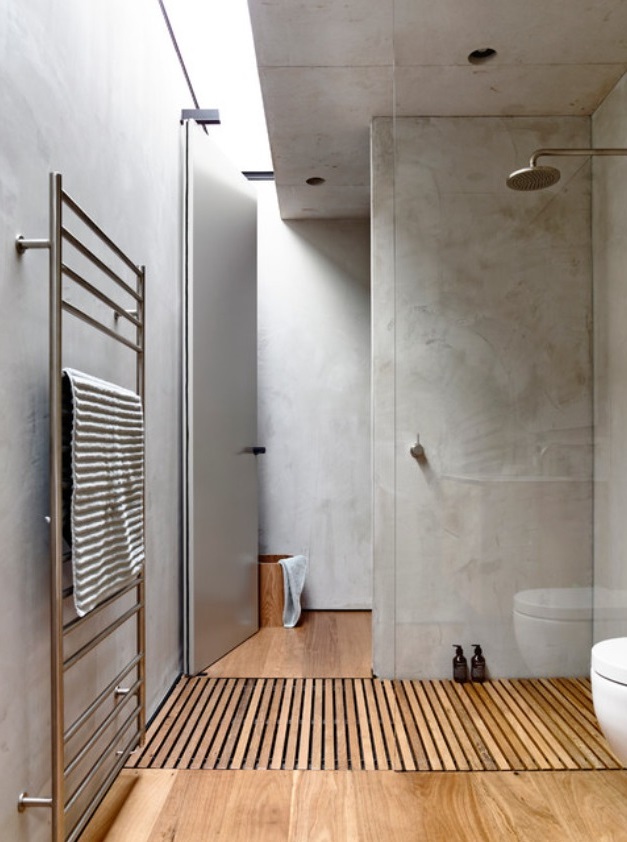
This type of wood is suitable for damp rooms.
Not all types of wood are suitable for damp rooms. Hardwoods such as teak, oak, and mahogany are highly resistant to moisture due to their natural oils and dense structure. These properties prevent water from penetrating the wood and causing damage such as warping or mould growth.
Although technically not wood but grass, bamboo is also valued for its resistance to moisture. It offers an eco-friendly alternative that is sturdy and stylish. With proper care and maintenance, these materials can maintain the beauty of the bathroom for years.
Ornamental ladder for teak towels
Care and protection of wood in the bathroom
Proper care is essential to protect the wood in the bathroom. Sealants with natural oils or special varnishes protect the wood from moisture and water. Regular use of this product can significantly extend the life of wood and maintain its natural beauty.
It is also essential to protect the wood from direct contact with water. Although treated wood is resistant to moisture, avoiding standing water and drying regularly after use will prolong the material’s durability. Thoughtful placement in the bathroom can help prevent direct splash areas.
Combinations with other materials are possible.
Wood combines beautifully with other materials to create a unique and attractive bathroom design. Combining wood with stone or tile can make an exciting contrast that highlights the natural beauty of wood. On the other hand, glass accents can brighten a room and add a modern touch.
Metals such as copper or stainless steel in fixtures, fittings, and wood can create a warm yet modern atmosphere. The right combination of materials can help find a harmonious balance between tradition and modernity, between nature and technology.
Combination of wood and Glass in the bathroom
Glass and other innovative materials
Glass and other innovative materials are revolutionizing modern bathroom design. They offer functional advantages and aesthetic freedom that traditional materials do not allow. These materials open up a new dimension in interior design by bringing light, transparency and a sense of openness into the room.
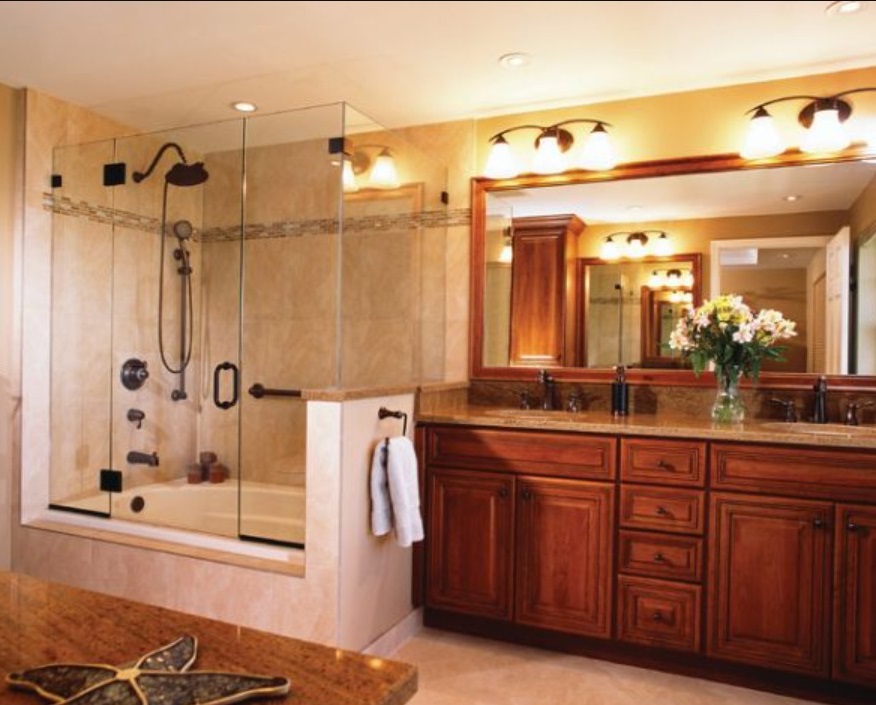
Use of Glass for open room design
Glass plays a central role in creating an open and bright bathroom. By using glass walls or doors, separate areas can be defined without disrupting the visual flow. This increases the feeling of space and ensures the distribution of natural light throughout the room.
Glass shower cubicles are famous for making modern bathrooms appear airy and open. They provide the necessary privacy while allowing light to enter unimpeded. Such a solution helps make a smaller bathroom appear more prominent and improves the room’s overall appearance.
Innovative materials and their applications
Various innovative materials are used in modern bathroom designs, apart from Glass. High-performance plastics, composites, and resins are just a few examples, and they are valued for their water resistance, durability, and wide range of design options.
These materials make unique surfaces and structures unthinkable in traditional bathrooms. From see-through sinks to seamless floor coverings, they offer various options for designing individual and innovative bathrooms.
Conclusion: An innovative design option in a tileless bathroom
An alternative to traditional tiles can transform a bathroom into a haven of relaxation and design. Plaster and micro-cement, natural stone, wood, Glass, and other innovative materials offer a wide range of options for designing individual and aesthetic spaces. These materials combine functionality with modern design, creating a warm and inviting atmosphere.
These alternatives encourage flexibility in design. The choice of finishes, colours, and textures is nearly limitless, reflecting an individual’s style and preferences. Additionally, innovative solutions such as targeted lighting and the combination of different materials contribute to a unique bathroom experience.
In short, moving from traditional tiles to more creative and adaptable materials opens the door to a new dimension in bathroom design. The alternatives presented not only offer aesthetic and functional benefits but also the opportunity to create a private retreat that is both relaxing and inspiring.
Frequently asked questions about bathrooms without tiles
Can I use wood in a humid bathroom environment without causing damage?
Yes, wood can be used in damp bathroom environments as long as it is properly cared for. Certain types of wood, such as teak, cedar, or bamboo, are especially suitable because their natural oils and resins repel moisture. Protective treatment with a waterproof sealant or varnish is essential to protect the wood from moisture damage. Regular maintenance, such as wiping off water and avoiding standing water, also helps maintain the longevity and beauty of bathroom wood.
Is natural stone in the bathroom challenging to care for?
Natural stones require some maintenance but are only sometimes challenging to care for. Regular cleaning with pH-neutral cleaning products and avoiding acidic products help maintain the stone’s natural beauty. Some natural stones may need to be sealed to make them more resistant to water, oil, and other liquids. However, with proper care, natural stone can be a very durable and attractive choice for a bathroom, even gaining character over time.
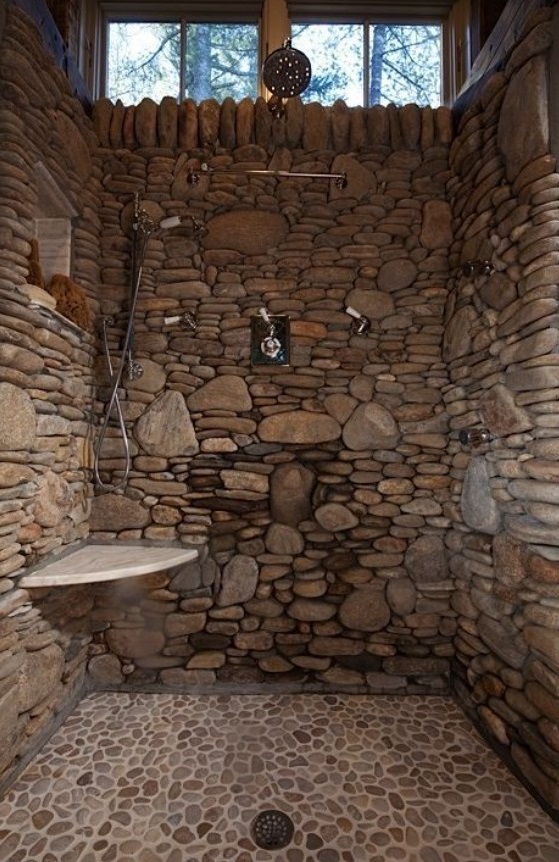
How does using GlGlassn in the bathroom affect the room?
Using GlGlassn in the bathroom, especially shower cubicles or partitions can make the room more spacious and open. GlGlassllows unobstructed views and maximizes the distribution of natural light, which is especially beneficial in small bathrooms. It promotes a modern, clean aesthetic and can be easily combined with other materials, such as wood or natural stone, to achieve different styles. Easy to care for and long-lasting, GlGlassffers is a practical solution for open and inviting bathroom designs.
Which innovative materials are best suited for bathrooms without tiles?
In addition to traditional materials such as wood, GlGlassnatural stone, resins, high-performance plastics, and micro-cement, innovative materials are perfect for bathrooms without tiles. These materials offer a variety of design options, from unique colours to customized textures and patterns. This material is waterproof, durable, and easy to care for, making it ideal for use in wet areas. Innovative materials allow for seamless integration on various surfaces, contributing to a modern and minimalist look that is functional and stylish at the same time.
